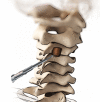Hemipartial Laminectomy and Bilateral Flavectomy Technique With Unilateral Approach in Patients With Cervical Spinal Stenosis Due to Ligamentum Flavum Hypertrophy: A Technique Note
- PMID: 34987923
- PMCID: PMC8717745
- DOI: 10.7759/cureus.20040
Hemipartial Laminectomy and Bilateral Flavectomy Technique With Unilateral Approach in Patients With Cervical Spinal Stenosis Due to Ligamentum Flavum Hypertrophy: A Technique Note
Abstract
The aim of this procedure is to widen the spinal canal by using minimally invasive techniques to do hemipartial laminectomy and bilateral flavectomy in patients with cervical spinal stenosis due to ligamentum flavum hypertrophy. A 66-year-old man presented with increasing neck and right shoulder pain for one year to Koç University Hospital. He reported a three-month history of numbness in his hands. The Japanese Orthopedic Association (JOA) and Visual Analogue Scale (VAS) scores were 15 and 8, respectively. Preoperative magnetic resonance imaging (MRI) revealed spinal canal stenosis at the C3-4 level secondary to ligamentum flavum hypertrophy. Hemi-partial laminectomy at the C3 level, flavectomy, and bilateral decompression were performed using the right unilateral approach. The patient's complaints of symptoms considerably decreased three months later. The VAS and JOA scores were 2 and 16, respectively. This minimally invasive approach can be an alternative to classic laminectomy in patients who have radiculopathy and myelopathy due to posterior origin spinal stenosis in order to safely resolve pain and neurologic dysfunction.
Keywords: flavectomy; hemipartial laminectomy; ligamentum flavum hypertrophy.
Copyright © 2021, Senturk et al.
Conflict of interest statement
The authors have declared that no competing interests exist.
Figures




Similar articles
-
Extensive laminectomy for multilevel cervical stenosis with ligamentum flavum hypertrophy: more than 10 years follow-up.Eur Spine J. 2015 Aug;24(8):1605-12. doi: 10.1007/s00586-014-3459-8. Epub 2014 Jul 11. Eur Spine J. 2015. PMID: 25011584
-
[CLINICAL OBSERVATION OF POSTERIOR CERVICAL DECOMPRESSIVE LAMINECTOMY AND LATERAL MASS SCREW FIXATION COMBINED WITH FORAMINOTOMY FOR CERVICAL RADICULO-MYELOPATHY].Zhongguo Xiu Fu Chong Jian Wai Ke Za Zhi. 2016 Aug 8;30(8):980-984. doi: 10.7507/1002-1892.20160199. Zhongguo Xiu Fu Chong Jian Wai Ke Za Zhi. 2016. PMID: 29786229 Chinese.
-
Posterior Percutaneous Endoscopic Technique Through Bilateral Translaminar Osseous Channels for Thoracic Spinal Stenosis Caused by Ossification of the Ligamentum Flavum Combined with Disk Herniation at the T10-11 Level: A Technical Note.World Neurosurg. 2020 Jan;133:135-141. doi: 10.1016/j.wneu.2019.08.215. Epub 2019 Sep 7. World Neurosurg. 2020. PMID: 31505277
-
Cervical myelopathy resulting from combined ossification of the ligamentum flavum and posterior longitudinal ligament: report of two cases and literature review.Spine J. 2013 Jan;13(1):e1-6. doi: 10.1016/j.spinee.2012.10.038. Epub 2012 Dec 21. Spine J. 2013. PMID: 23266147 Review.
-
Symptomatic hematoma of cervical ligamentum flavum: case report.Spine (Phila Pa 1976). 2005 Aug 15;30(16):E489-91. doi: 10.1097/01.brs.0000174282.71947.c7. Spine (Phila Pa 1976). 2005. PMID: 16103845 Review.
References
-
- Postlaminectomy kyphosis. Albert TJ, Vacarro A. Spine (Phila Pa 1976) 1998;23:2738–2745. - PubMed
-
- Evaluation of cervical laminectomy and laminoplasty. A longitudinal study in the goat model. Baisden J, Voo LM, Cusick JF, Pintar FA, Yoganandan N. Spine (Phila Pa 1976) 1999;24:1283–1288. - PubMed
-
- Spinal deformity and instability after multilevel cervical laminectomy for spondylotic myelopathy. Guigui P, Benoist M, Deburge A. Spine (Phila Pa 1976) 1998;23:440–447. - PubMed
-
- Comparison of anterior cervical decompression and fusion versus laminoplasty in the treatment of multilevel cervical spondylotic myelopathy: a meta-analysis of clinical and radiological outcomes. Montano N, Ricciardi L, Olivi A. World Neurosurg. 2019;130:530–536. - PubMed
-
- Spinal deformity and instability after multilevel cervical laminectomy. Mikawa Y, Shikata J, Yamamuro T. Spine (Phila Pa 1976) 1987;12:6–11. - PubMed
LinkOut - more resources
Full Text Sources
Miscellaneous
